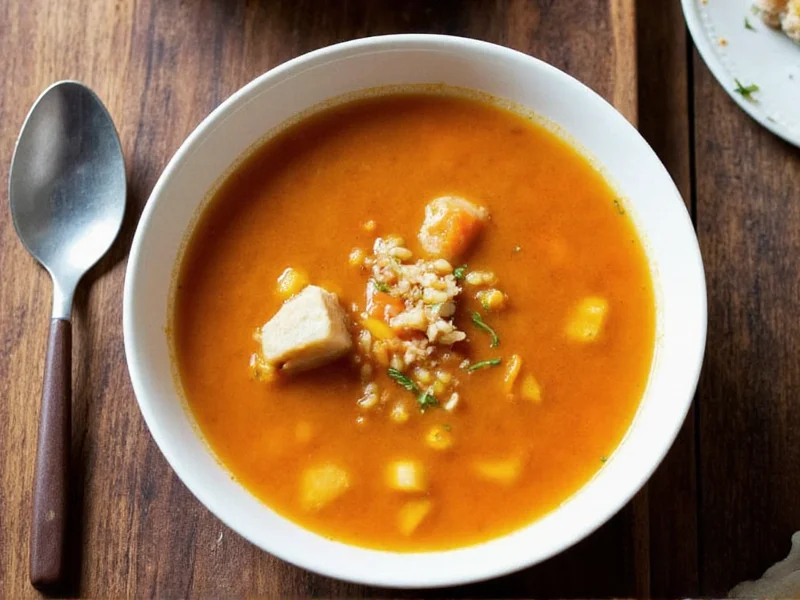Creating exceptional bone broth isn't just about following steps—it's understanding the science behind extraction and the culinary art of building deep flavor. This comprehensive guide reveals professional techniques for making bone broth that maximizes both nutrition and taste, whether you're using a slow cooker, pressure cooker, or traditional stovetop method.
The Nutritional Powerhouse in Your Kitchen
Bone broth has been valued across cultures for centuries, and modern research supports many of its traditional benefits. When properly prepared, bone broth delivers bioavailable minerals like calcium, magnesium, and phosphorus. The extended simmering process breaks down collagen into gelatin, which contains amino acids like glycine and proline that support joint health and gut integrity. Unlike store-bought versions, homemade bone broth contains no preservatives and significantly higher nutrient levels.
Why Bone Selection Matters More Than You Think
The quality of your bones directly determines your broth's nutritional profile and flavor depth. For optimal results:
- Chicken bones—Use a combination of knuckles, feet, and backs for maximum collagen
- Beef bones—Marrow bones and knuckles provide rich flavor and abundant nutrients
- Fish bones—Head bones and frames create delicate, mineral-rich stock
Always choose bones from pasture-raised, organic animals when possible. These contain higher levels of omega-3 fatty acids and fewer toxins than conventionally raised sources. The presence of connective tissue and joints in your bone selection dramatically increases the gelatin content of your finished broth.
Essential Equipment for Perfect Bone Broth
| Equipment | Why It Matters | Professional Tip |
|---|---|---|
| Large stockpot (8-12 quart) | Provides adequate space for ingredients without overcrowding | Use enameled cast iron for even heating and no metallic taste |
| Fine-mesh strainer | Removes all sediment for crystal-clear broth | Line with cheesecloth for ultra-smooth results |
| Storage containers | Preserves freshness and prevents freezer burn | Use wide-mouth jars leaving 1-inch headspace for expansion |
Step-by-Step Bone Broth Preparation
Preparation (15 minutes)
Begin by roasting your bones at 400°F for 30-45 minutes until golden brown. This crucial step develops complex flavor compounds through the Maillard reaction. While bones roast, chop vegetables into large chunks—precision isn't necessary since they'll be strained out later.
Cooking Process (12-24 hours)
- Place roasted bones in your stockpot
- Add vegetables, garlic, and 2 tablespoons apple cider vinegar
- Cover completely with cold filtered water (12 cups for 4 pounds bones)
- Bring to gentle simmer—never a rolling boil
- Skim foam during first 30 minutes for clear broth
- Add herbs after 2 hours of simmering
- Maintain bare simmer for 12-24 hours (chicken) or 18-24 hours (beef)
The vinegar's acidity helps extract minerals from bones, while the low-and-slow cooking preserves delicate nutrients that high heat would destroy. Properly made broth will gel when cooled, indicating abundant collagen extraction.
Pro Techniques for Superior Results
Professional chefs employ several advanced methods that elevate homemade bone broth:
- Two-stage simmering—First simmer meaty bones for 2 hours, then add clean marrow bones for extended cooking
- Vegetable timing—Add root vegetables early, delicate herbs in final hours
- Fat management—Chill broth overnight, then remove solidified fat cap for cleaner flavor
- Concentration—Simmer finished broth an additional hour to intensify flavor
Storage and Culinary Applications
Properly stored, homemade bone broth maintains quality for:
- 5-7 days in refrigerator (in airtight container)
- 6-12 months in freezer (use ice cube trays for portioning)
- 12-18 months when pressure-canned
Use your bone broth as:
- Base for soups and stews (replaces water for richer flavor)
- Cooking liquid for grains like rice and quinoa
- Hydrating beverage with added sea salt
- Sauce thickener and flavor enhancer
Troubleshooting Common Issues
- Cloudy broth—Caused by boiling instead of simmering; strain through cheesecloth
- Weak flavor—Increase bone-to-water ratio or extend cooking time
- Bitter taste—Overcooked vegetables; remove veggies after 6 hours next time
- No gel—Insufficient connective tissue bones; add more knuckles or feet
Variations for Dietary Needs
Adapt your bone broth for specific requirements:
- Autoimmune protocol—Omit nightshades and use only approved vegetables
- Keto-friendly—Focus on marrow bones and add healthy fats like ghee
- Low-sodium—Skip added salt; rely on natural mineral content
- Vegetarian alternative—Use mushroom stems and seaweed for mineral content
Frequently Asked Questions
How long should I simmer bone broth for maximum benefits?
Chicken bones require 12-24 hours while beef bones need 18-24 hours. The extended time breaks down collagen into gelatin and extracts minerals. However, don't exceed 24 hours as nutrients can degrade. The broth should gel when chilled, indicating proper collagen extraction.
Can I use a pressure cooker for bone broth without losing nutrients?
Yes, a pressure cooker reduces cooking time to 2-3 hours while maintaining nutrient density. The sealed environment preserves volatile compounds better than open-pot simmering. For optimal results, use natural release rather than quick release to maintain delicate nutrients.
Why does my bone broth not gel after cooling?
Lack of gel indicates insufficient collagen extraction. This typically happens when using too few connective tissue bones (like knuckles or feet). For chicken broth, include at least 25% feet or wings. For beef, use marrow bones plus knuckles. The vinegar addition is also crucial for mineral extraction that supports gel formation.
What's the difference between bone broth and regular stock?
Bone broth simmers significantly longer (12-24 hours versus 3-4 hours for stock), extracting more collagen and minerals from bones. It contains higher levels of gelatin and amino acids. Stock typically uses more meaty bones with shorter cooking times, resulting in less gelatinous, more immediately flavorful liquid primarily for cooking rather than drinking.
How can I enhance the flavor of my bone broth without adding salt?
Roast bones thoroughly before simmering, add umami-rich ingredients like dried mushrooms or tomato paste, and include aromatic vegetables (onion, celery, leek). Fresh herbs added in the final hour provide brightness. A splash of lemon juice or apple cider vinegar at serving time enhances overall flavor perception without additional sodium.











 浙公网安备
33010002000092号
浙公网安备
33010002000092号 浙B2-20120091-4
浙B2-20120091-4